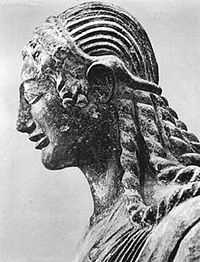Tyrrhenians
The Tyrrhenians (Attic Greek: Τυρρηνοί Turrhēnoi) or Tyrsenians (Ionic: Τυρσηνοί Tursēnoi; Doric: Τυρσανοί Tursānoi[1]) is an exonym used by Greek authors to refer to a non-Greek people.
While ancient sources have been interpreted in a variety of ways, one theory identifies the Tyrrehians with the Etruscan, Raeti, and Lemnian cultures, whose languages have been grouped together as the Tyrsenian languages based on strong similarities in their written languages.
Earliest references
The origin of the name is uncertain. It is only known to be used by Greek authors, but apparently not of Greek origin. It has been connected to tursis, also a "Mediterranean" loan into Greek, meaning "tower" (see there). Direct connections with Tusci, the Latin exonym for the Etruscans, from Turs-ci have also been attempted.[2] See also Turan, tyrant.
The earliest instances in literature are in Hesiod and the Homeric hymn to Dionysus. Hesiod has
And they [the sons of Circe] ruled over the famous Tyrsenians, very far off in a recess of the holy islands.[3]
The Homeric hymn to Dionysus has Tyrsenian pirates seizing Dionysus,
Presently there came swiftly over the sparkling sea Tyrsenian pirates on a well-decked ship — a miserable doom led them on.[4]
Possible identification with the Etruscans
Later, in the 6th to 5th centuries BC, the name referred specifically to the Etruscans, for whom the Tyrrhenian Sea is named, according to Strabo.[5] In Pindar,[6] the Tyrsanoi appear grouped with the Carthaginians as a threat to Magna Graecia:
I entreat you, son of Cronus, grant that the battle-shouts of the Carthaginians and Etruscans stay quietly at home, now that they have seen their arrogance bring lamentation to their ships off Cumae.
The name is also attested in a fragment by Sophocles.[7]
The name becomes increasingly associated with the generic Pelasgians. Herodotus[8] places them in Crestonia in Thrace, as neighbours of the Pelasgians. Similarly, Thucydides[9] mentions them together with the Pelasgians and associates them with Lemnian pirates and with the pre-Greek population of Attica.
Lemnos remained relatively free of Greek influence up to Hellenistic times, and interestingly, the Lemnos stele of the 6th century BC is inscribed with a language very similar to Etruscan. This has led to the postulation of a "Tyrrhenian language group" comprising Etruscan, Lemnian and Raetic.
There is thus evidence that there was indeed at least a linguistic relationship between the Lemnians and the Etruscans. The circumstances of this are disputed; a majority of scholars, at least in Italy, would ascribe Aegean Tyrrhenians to the Etruscan expansion from the 8th to 6th centuries, putting the homeland of the Etruscans in Italy and the Alps particularly because of their relation to the Alpine Raetic population.
Another hypothesis connecting the Tyrrhenians and the Etruscans posits that the Etruscans derive at least partially from a 12th-century BC invasion from the Aegean and Anatolia imposing itself over the Italic Villanovan culture, with some scholars claiming a relationship or at least evidence of close contact between the Anatolian languages and the Etruscan language. There is no archaeological evidence from material culture of such a cultural shift, but adherents of this latter school of thought point to the legend of Lydian origin of the Etruscans referred to by Herodotus (Histories 1.94) and the statement of Livy that the Raetians were Etruscans driven into the mountains by the invading Gauls. Critics of this theory point to the very scanty evidence of a linguistic relationship of Etruscan with Anatolian, and to Dionysius of Halicarnassus who decidedly argues against an Etruscan-Lydian relationship.
Identification with the name Spard
"Spard" or "Sard", another name closely connected to the name Tyrrhenian, was the capital city of the land of Lydia, the original home of the Tyrrhenians; it was referred to by the Greeks as "Sardis". The name preserved by Greek and Egyptian renderings is "Sard," for the Greeks call it "Sardis" and the name appears in the Egyptian inscriptions as "Srdn."[10]
References
- ↑ Τυρσηνός, Henry George Liddell, Robert Scott, A Greek-English Lexicon, on Perseus
- ↑ Alfred Heubeck, Praegraeca: sprachliche Untersuchungen zum vorgriechisch-indogermanischen Substrat, (Erlangen) 1961:65f.
- ↑ Hesiod, Theogony 1015.
- ↑ Homeric hymn to Dionysus, verses 7f.
- ↑ Strabo, 5.2.2.
- ↑ Pindar, Pythian Odes 1.72
- ↑ Sophocles, Inachus, fr. 256
- ↑ Herodotus 1.57
- ↑ Thucydides 4.106
- ↑ David Neiman, "Sefarad: The Name of Spain", Journal of Near Eastern Studies Vol. XXII, No. 2, April 1963
| |||||||||||||||||||||||||||||||||
